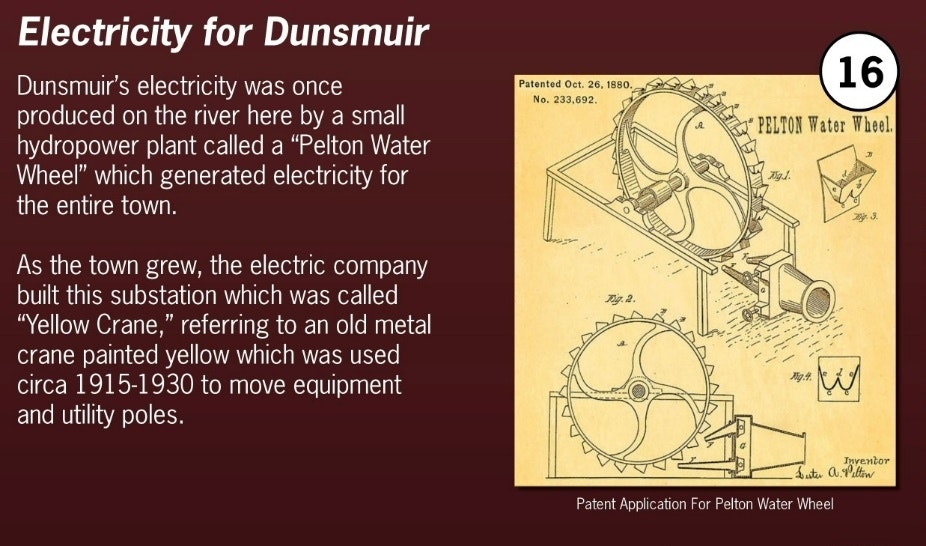Self-Guided Tour Sign #16 – Electricity for Dunsmuir

With the arrival of the new town of Dunsmuir in the late 1880s, there was a need for the town to have electric power. Electricity as a utility was still very much a novelty in the 1880s, and often it was local entrepeneurs who pulled together some money to create a small power plant and get the agreement of the town to string electric lines along the streets and into people's businesses and homes.
A popular way to generate electricity at this local level was with "Pelton Water Wheels"--named after their inventor, Lester Pelton. Pelton took existing designs for waterwheels and improved them to make better use of the energy in fast-moving water. His original Pelton Water Wheels were first used beginning in the 1870s in California gold mining to operate the machinery there.
By the 1880s, the Pelton Water Wheel Company (based in San Francisco) began selling Pelton Water Wheels to businesses to generate electricity, and at the height of its popularity, the company had sold over 11,000 Pelton Water Wheels in the United States.
To generate electricity, the Pelton Water Wheel turned a small turbine containing magnets and wires. The turning turbine created electricity, which then traveled by newly-installed wires into the businesses and homes of its customers.
In 1891, local entrepeneur Herman Scherrer installed the first electricity-generating plant using a Pelton Water Wheel for the new town of Dunsmuir, as well as for the long-established Upper Soda Springs Resort located here. In addition, the Mossbrae Falls Water and Power Company also began supplying electricity and water service to Dunsmuir.
After a number of years, it became clear that demand for electricity in Dunsmuir (and elsewhere in Siskiyou County) was increasing past the ability of local providers to generate enough electricity.
In 1903, a new company, the Siskiyou Electric Power Company, finished building a larger power plant located at Fall Creek, and began extending power lines from its new plant--first to Yreka and then south towards Dunsmuir. A new company, the Siskiyou Electric Power and Light Co. , aquired this company, and completed extending new power lines to Dunsmuir in 1909, and the local Pelton Water Wheel and Mossbrae Falls equipment were retired. (The electric power lines that you can see extending north of the substation here follow the path of these original 1909 power lines.)
In 1911, still another new company, named the California-Oregon Power Co., better known as "Copco", acquired the existing power company.
Copco greatly expanded its ability to generate electricity, for example by building dams on the Klamath River. By about 1915, Copco built the first substation here on the property of the Upper Soda Springs Resort, to handle the electricity for Dunsmuir. By 1918, Copco had extended its power lines south down the Sacramento River Canyon to the copper mining town of Kennett (now under the waters of Lake Shasta). In Kennett, Copco was able to connect its power lines to the larger regional electric grid of the Pacific Gas and Electric Company (better known as "PG&E").
In 1961, Copco was purchased by Pacific Power and Light, based in Portland, Oregon--which continued to operate Dunsmuir's electricity under the name "Copco"; however, the name "Copco" was eventually retired and Dunsmuir's electric company is now known by the new name of the parent company, "PacifiCorp".
In a twist of history, the two original dams built on the Klamath River 100 years ago to provide electricity to Dunsmuir have been ordered to be dismantled to allow the return of the salmon run on the Klamath River. Dunsmuir's electricity is now provided from a wide variety of sources, including from Shasta Dam, as well as solar, wind, and other hydropower sources.


